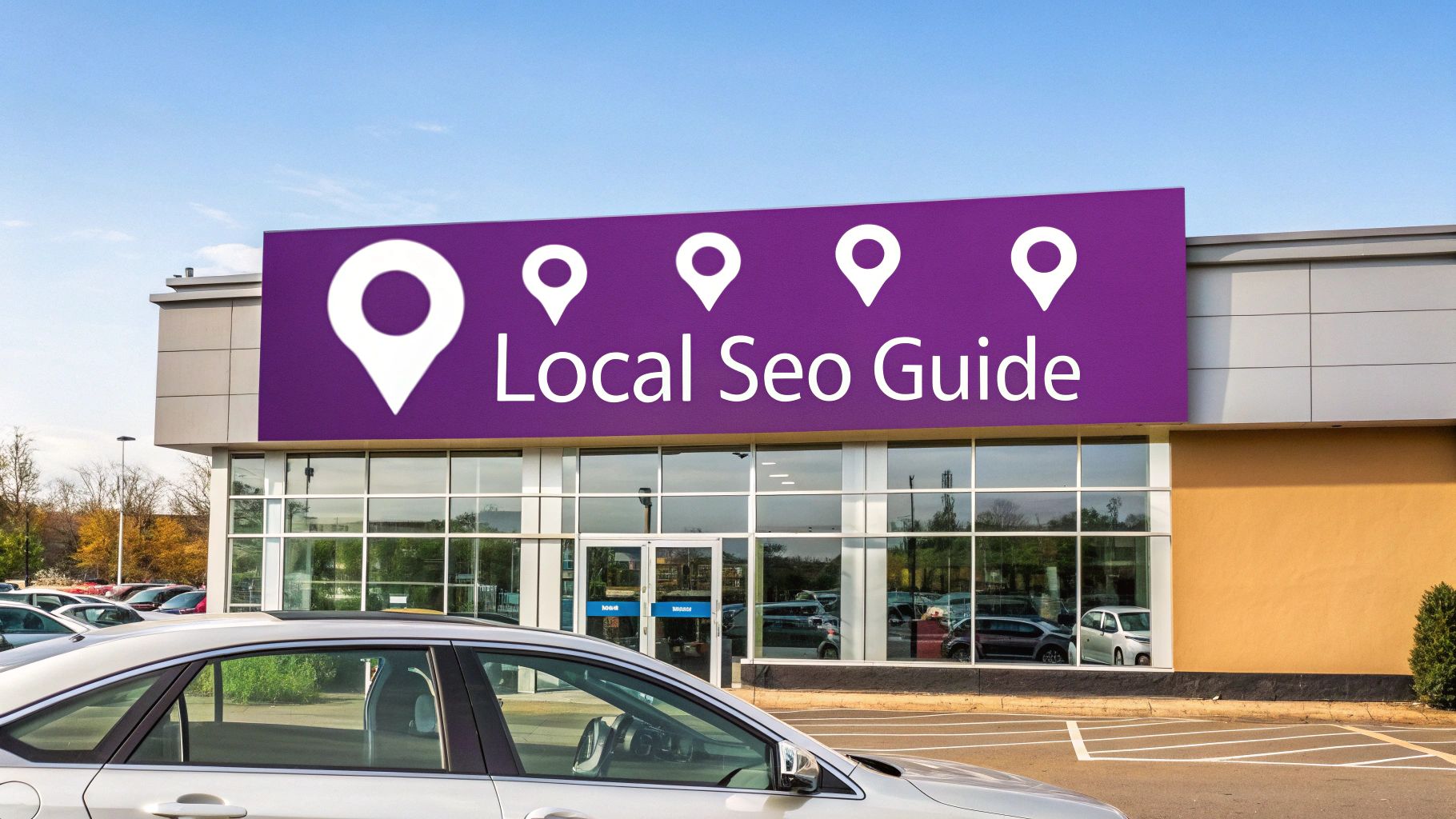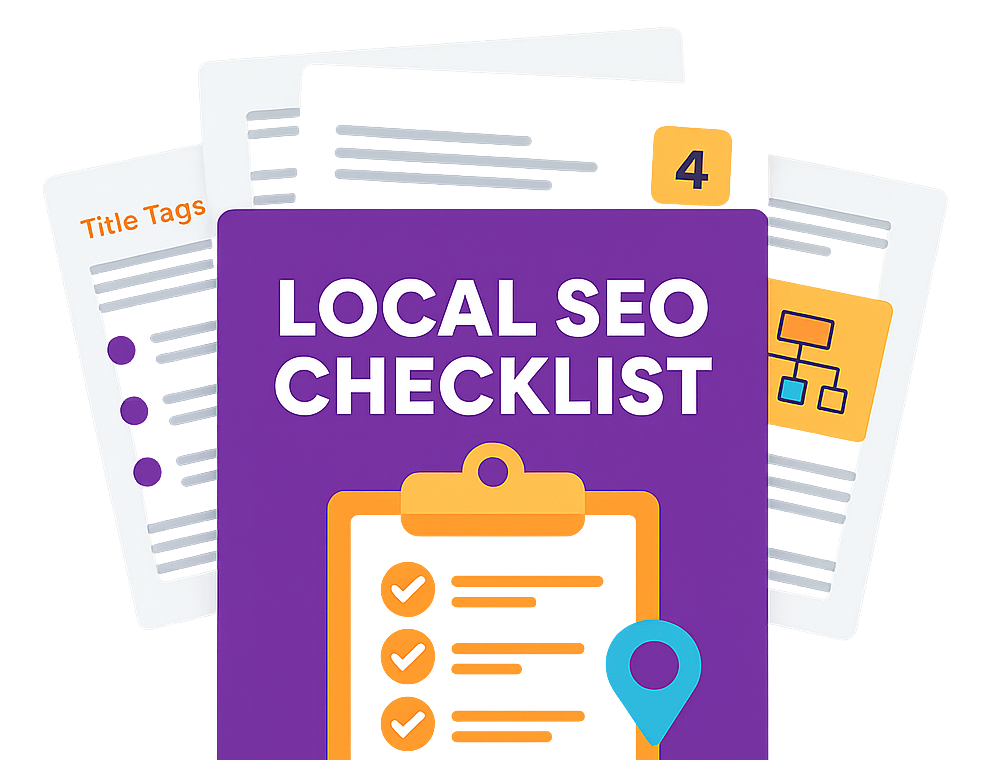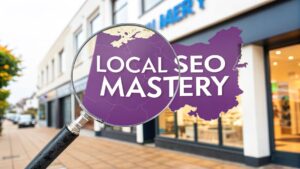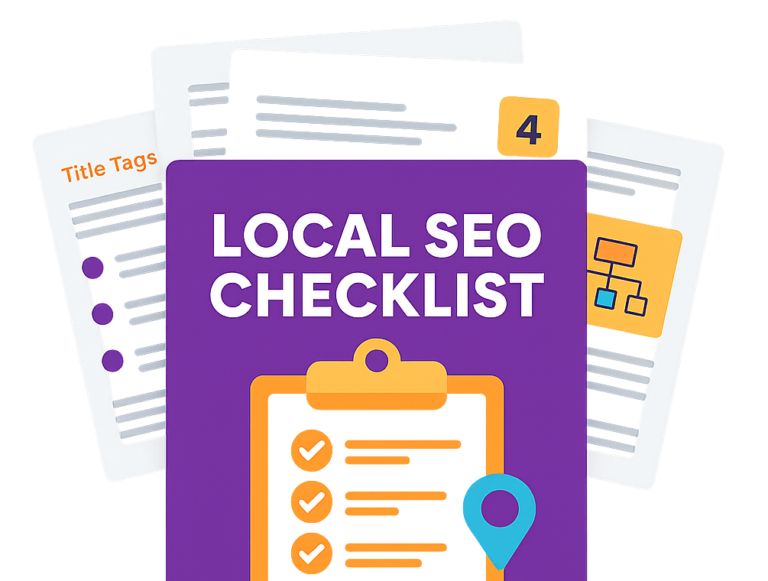Local SEO for car dealerships is all about making sure your showroom pops up when local customers search online. When someone in Manchester types in “used Ford Focus in Manchester” or a driver nearby looks for “car servicing near me,” you need to be the first name they see on Google and Maps. It’s that simple. It’s about connecting your physical forecourt to the digital world where your customers live.
Why Your Showroom Can't Afford to Ignore Local SEO
Let's be real—the car-buying journey almost never starts on the forecourt anymore. It kicks off with a quick search on a phone or laptop, usually from the comfort of someone's sofa. This fundamental shift means a strong digital presence isn't just a nice-to-have; it's essential for survival.
For any car dealership, local search engine optimisation (SEO) is your most powerful tool for growth. It’s the engine that drives qualified, local customers straight to your website and, ultimately, through your showroom doors. This isn't about casting a wide, expensive net. It’s about being the most visible, trusted, and helpful answer for buyers right in your backyard.
Bridging the Digital and Physical Showrooms
Great local SEO closes the gap between an online search and a real-life visit. When a potential buyer searches for 'Audi dealer in Bristol,' they're not just window shopping—they’re ready to buy. Appearing at the top of those results immediately positions your dealership as the go-to authority in the area.
The numbers don't lie. A staggering 95% of car buyers now start their journey online, researching vehicles and local dealers long before they think about a test drive. This paints a clear picture: if you're not visible online, you're invisible to almost all of your potential customers. You can dig deeper into how vital this research phase is for UK car buyers by checking out the latest data from Senotrix.
Capturing High-Intent Local Traffic
Think about the actual phrases people are typing into Google every day:
- "Best place to trade in my car in Leeds"
- "Authorised used BMW X5 near me"
- "MOT test centre in Cardiff"
Each of these searches comes from a customer who is ready to act. A sharp local SEO strategy ensures your dealership ranks for these high-value terms, funnelling this motivated traffic directly to your website or Google Business Profile.
A strong local SEO presence doesn't just get you website clicks. It drives phone calls, direction requests, and test drive bookings. It's the most direct line from a local searcher's need to your sales team's next opportunity.
Your Google Business Profile, for instance, is your digital billboard. It gives potential customers all the key information they need at a glance.
Here’s a look at the Google Business Profile management dashboard, where you can control all of this crucial information.

This is your central hub for managing everything from opening hours and services to customer reviews and photos—all of which directly impact how you show up in local search results.
Optimising Your Google Business Profile
Think of your Google Business Profile (GBP) as the digital front door to your dealership. For most people searching locally, it’s the very first time they’ll encounter your business. A neglected, half-empty profile is like a dusty, unlit showroom—it sends potential buyers straight to your competitors.
On the other hand, a fully built-out GBP acts as your most powerful tool for attracting local customers. It’s far more than just a listing; it’s a dynamic space where you can show off your latest stock, prove your expertise, and build trust before anyone even steps onto your forecourt. Getting this right is a cornerstone of effective local SEO for car dealerships.
Nailing the Fundamentals First
Before you get into the fancier features, it’s critical to get the absolute basics right. Any inaccuracies here can actively drag down your local rankings and frustrate would-be customers.
Your first job is to ensure your core business information is perfect—not just present, but precise and consistent across the web. This means your dealership's Name, Address, and Phone number (NAP) must be identical to what’s on your website and anywhere else you’re listed online. No variations.
Beyond the NAP, your category selection is make-or-break. Google gives you specific options to tell it exactly what you do, so choose carefully.
- Primary Category: For most dealerships, this will simply be ‘Car Dealer’. If you only sell used vehicles, then ‘Used Car Dealer’ is the better fit. This single choice carries the most weight in how Google understands and ranks your business.
- Secondary Categories: Don’t stop at one. Layer in relevant secondary categories to show up for a wider range of searches. Think ‘Car Repair and Maintenance’, ‘MOT Station’, or ‘Car Parts and Accessories Store’ to capture customers looking for those specific services.
Getting these details spot-on lays the foundation for everything else. For a more detailed walkthrough, our complete guide to Google My Business optimisation covers the setup process from start to finish.
Creating a Visual and Informative Profile
Once the foundations are solid, it's time to bring your digital showroom to life. A profile with just a name and address is uninspiring. Your goal is to make it the most helpful, engaging, and visually appealing result a local car buyer could find.
Start with your business description. This is your pitch. Write a compelling summary of what makes your dealership the best choice locally. Weave in local keywords naturally, mentioning the towns or areas you serve and any brands you specialise in (e.g., "the leading authorised Ford dealer serving Cambridge and surrounding villages").
Next, go all-in on visuals. High-quality, up-to-date photos are non-negotiable.
- Showcase Your Stock: Get into the habit of regularly uploading clear photos of your latest arrivals. A potential buyer is far more likely to get in touch if they can see the actual cars on your forecourt right now.
- Highlight Your Facilities: Post pictures of your clean, professional showroom, your service bays, and your customer waiting area. It builds trust and shows you care about the customer experience.
- Introduce Your Team: A few friendly photos of your sales and service staff can make your dealership feel much more approachable and human.
Pro Tip: Before you upload any images, make sure you geotag them. Geotagging adds geographical coordinates to the image's data, giving Google another powerful signal that your business is anchored in a specific location.
Leveraging Advanced GBP Features
To really pull ahead of the competition, you need to use the full toolkit Google provides. These features are designed to boost engagement and give customers timely information directly in the search results, making it easier for them to choose you.
Google Posts are like free mini-adverts for your dealership. Use them constantly to:
- Announce new vehicle arrivals.
- Promote seasonal service offers (e.g., "Winter Health Check for only £29").
- Share news about community events you're sponsoring.
- Highlight fantastic customer testimonials.
Just remember, Posts expire after seven days, so consistent activity is essential to keep your profile looking fresh and active.
The Q&A feature is another powerful tool that most dealerships ignore. People can ask questions directly on your profile, and you need to be monitoring this section to provide quick, helpful answers. Even better, be proactive. Populate it yourself by asking and answering the common questions you get every day, like "Do you offer financing options?" or "What are your weekend opening hours?". This anticipates customer needs and positions you as the expert.
Finally, use the Products/Services section to meticulously list everything you offer. Don't just put 'Car Sales'. Break it down into 'New Car Sales', 'Used Car Sales', and 'MOTs', and give each one a proper description. The more detailed you are, the more chances you have to rank for those specific, high-intent searches.
Building Trust With Online Reviews
Online reviews are so much more than just star ratings. They're the modern-day version of word-of-mouth, acting as a massive trust signal for both potential customers and Google’s algorithm. For car dealerships, your online reputation isn't just a passive score; it's an active asset that directly influences your local search rankings and whether a buyer walks into your showroom or the one down the road.
When a customer leaves a review, they’re sharing the story of their experience. Simply responding to these stories—the good, the bad, and the lukewarm—shows you're listening and that you genuinely value their business. That simple act of engagement builds a layer of trust that no static marketing campaign can ever hope to replicate.

Encouraging a Stream of Positive Feedback
The first hurdle is actually getting your happy customers to share their experiences. Most people won't think to leave a review unless you prompt them, so you need a dead-simple, frictionless process to ask for feedback right at that peak moment of satisfaction—usually just after they’ve driven off the forecourt in their shiny new car.
A few effective, low-pressure tactics I’ve seen work wonders include:
- Sending a follow-up email or text. A day after the sale, a quick, personalised message thanking the customer with a direct link to your Google review page is incredibly effective. Simplicity is everything here.
- Using QR codes in the showroom. Place small, well-designed flyers with a QR code at the point of sale or in the service waiting area. This makes it effortless for customers to leave feedback on the spot while they wait.
- Training your sales team. Coach your staff to mention how much a review would be appreciated as part of their handover process. A personal request from the person they’ve just built a rapport with is often the most powerful prompt.
The goal is to make it as easy as humanly possible. The fewer clicks it takes, the more reviews you’ll get.
Responding to Every Type of Review
How you handle the reviews you receive is just as important as getting them in the first place. A thoughtful response strategy shows everyone—including Google—that you’re an engaged, professional, and customer-focused dealership. This is a non-negotiable part of any solid online reputation management and SEO strategy.
Your approach should change depending on the review’s sentiment.
For Positive Reviews (4-5 stars):
Don't just drop a generic "thanks." Get personal. Mention the salesperson they worked with by name or the specific car they bought. This tiny detail shows a real person is reading their feedback and validates their great experience.
For Neutral Reviews (3 stars):
These often contain a mix of good and bad points. Always thank them for the positive feedback first, then professionally acknowledge their constructive criticism. This can turn a lukewarm review into a public demonstration of your commitment to improving.
Responding thoughtfully to a negative review can be more powerful than a dozen positive ones. It shows transparency, accountability, and a genuine desire to resolve issues, which builds immense trust with potential customers observing from the sidelines.
For Negative Reviews (1-2 stars):
It’s critical to respond quickly, calmly, and professionally. Always.
- Acknowledge and Apologise: Start by acknowledging their frustration and apologising that their experience didn't live up to expectations.
- Take it Offline: Provide a direct contact name, email, or phone number. Invite them to discuss the matter privately so you can resolve it away from the public eye.
- Never Argue: Avoid getting into a public back-and-forth. Your response isn't about winning an argument; it's about showing other potential customers that you take feedback seriously and handle problems professionally.
This structured approach helps mitigate any damage and can often turn a negative into a positive. You're signalling a commitment to customer satisfaction, which resonates strongly with both people and search engines.
Recent data really brings home how crucial these ratings are for UK franchise dealerships. A Q1 2025 analysis from Localise.co.uk found that 43.1% of franchise dealers hit a top-tier Google rating of 4.5 stars or higher, while another 50.2% held a strong 4.0 to 4.5-star rating. This proves the vast majority of successful dealerships maintain excellent customer sentiment, which is directly tied to better local search performance.
On-Page SEO for Your Dealership Website
Your Google Business Profile is a brilliant magnet for pulling in local searchers, but your dealership's website is where the real magic happens. This is your digital forecourt, the place where you turn casual interest into a test drive or a sale. On-page SEO is all about fine-tuning your website's content and structure to send crystal-clear signals to search engines about who you are, where you are, and what you sell.
Getting this right is what separates you from the competition in local search results. It’s about transforming your website from a simple online brochure into a high-performance engine for attracting local car buyers.
Crafting Locally Focused Page Titles and Descriptions
Think of your page's title tag and meta description as your digital shop window. They're the very first thing a potential customer sees in the search results, so they need to be compelling, relevant, and speak directly to local buyers.
A generic title like "Used Cars for Sale" is a missed opportunity. Instead, get specific and location-driven. A title like "Approved Used Audi Cars in Bristol | Bristol Audi Centre" instantly tells both Google and the user exactly what you offer and where they can find it.
The same logic applies to your meta descriptions. They need to be a short, persuasive summary of what's on the page, giving people a reason to click.
- Weak Example: "We sell a wide range of used cars. Contact us for more information."
- Strong Example: "Searching for a reliable used Vauxhall in Swindon? Discover our hand-picked selection of certified pre-owned vehicles with flexible financing. Visit us today for a test drive!"
These aren't huge changes, but they make a massive difference in attracting clicks from people who are genuinely local and ready to buy.
The Power of Localised Content
The real secret to climbing the local search rankings is creating content that's genuinely useful to your community. This goes way beyond just sprinkling your city's name across a few pages. It's about building dedicated pages and blog posts that solve the specific problems and answer the questions of car buyers in your patch.
For instance, create specific service pages for the towns and villages you serve. A page titled 'BMW Servicing in Reading' is far more effective at catching targeted traffic than a generic 'Our Services' page. On that page, you can mention local landmarks, give directions from a well-known roundabout, or even feature testimonials from your Reading-based customers. It adds a layer of authenticity that search engines love.
This graphic really paints a picture of how local searches drive traffic, hammering home the need to get your on-page elements spot-on to capture this valuable audience.

As the data shows, mobile is king for local searches. This makes it non-negotiable to have a mobile-friendly website that loads quickly and makes information easy to find on a small screen.
Your blog is another fantastic tool for local targeting. Think about articles like:
- "Best Family Cars for Driving in the Cotswolds"
- "Navigating Birmingham’s Clean Air Zone: Our Top ULEZ-Compliant Cars"
- "A Guide to the Best Scenic Drives Around the Peak District"
This kind of content doesn't just attract local searchers; it positions your dealership as a helpful local expert, building trust and authority long before they even step onto the forecourt. This is a cornerstone of any good content strategy, and you can dive deeper into these concepts in our comprehensive guide on on-page SEO best practices.
To help you get started, here’s a quick-glance table breaking down the most important on-page elements for a dealership website.
Key On-Page SEO Elements for Car Dealerships
| SEO Element | Optimisation Tactic | Example for a Bristol Dealership |
|---|---|---|
| Page Title | Include primary keyword, brand name, and location. Keep it under 60 characters. | Approved Used Audi A3 in Bristol | Bristol Audi Centre |
| Meta Description | Write a compelling summary with a clear call-to-action. Keep under 160 characters. | Find your perfect Approved Used Audi A3 in Bristol. All our cars come with a full service history & 12-month warranty. Book your test drive today! |
| H1 Heading | Use one unique H1 per page that clearly states the page's topic and location. | Approved Used Audi A3 Cars for Sale in Bristol |
| Body Content | Naturally weave in local keywords, mention nearby towns, and answer common local questions. | Mentioning "…ideal for navigating the narrow streets of Clifton" or "easy to reach from Bath and Weston-super-Mare." |
| Image Alt Text | Describe the image accurately using relevant local keywords. | A red 2022 Audi A3 parked at our Bristol dealership |
Focusing on these core elements ensures that every page on your site is working hard to attract the right local customers.
Technical Must-Haves for Local Relevance
All your great content needs to be supported by a solid technical foundation. There are a couple of non-negotiable elements that send direct signals about your local relevance to Google.
First up is your Name, Address, and Phone number (NAP). This info needs to be displayed consistently on your website, ideally in the footer of every single page. Critically, it must be an exact match to what’s on your Google Business Profile listing—no abbreviations, no variations, no exceptions.
Second, embed a Google Map on your contact page. This isn't just for helping customers find you; it's a powerful, visual signal to Google that confirms your physical location. It removes any doubt and strengthens your connection to the local area.
Key Takeaway: The consistency of your dealership’s Name, Address, and Phone number (NAP) across your website, Google Business Profile, and other online directories is one of the most critical ranking factors in local SEO. Inconsistencies create confusion for search engines and erode trust.
Building Local Authority and Links

While the content on your website is massively important, Google also cares a great deal about what the rest of the web is saying about you. This is where building local authority comes in. It’s about getting your dealership mentioned in the right places and earning links from other trusted local websites.
Think of it like building a solid reputation around town. The more positive chatter and connections you have, the more Google sees you as a legitimate, important local player. This process strengthens your digital footprint, making your dealership the go-to choice when people search nearby.
Mastering Local Citations
A citation is just a mention of your dealership's Name, Address, and Phone number (NAP) online. These are the absolute bedrock of local SEO. They act as digital signposts that confirm to search engines that your business is real, and that it's located exactly where you say it is.
The golden rule here is consistency. Your NAP information must be identical everywhere, right down to the last comma. A messy mix of "Ltd" and "Limited" or "St." and "Street" across different sites can confuse Google and seriously weaken the power of your listings.
Your first job is to tackle the big UK-based business directories. These are the modern Yellow Pages, and having a presence on them is simply non-negotiable.
Here are the essential UK directories to get sorted first:
- Yell.com: A household name and a high-authority listing you can't ignore.
- AutoTrader: Absolutely critical for any car dealership operating in the UK.
- The AA Garage Guide: A must-have if you offer servicing and MOTs.
- Thomson Local: Another long-standing and trusted UK business directory.
- Scoot: A popular network that also pushes your data out to other directories.
Nailing these creates a solid foundation you can build the rest of your local SEO on.
Earning Genuine Local Links
Beyond basic directory listings, local link building is about earning links from other websites in your community. These are a whole different ball game and are far more powerful than simple citations. A link from a respected local source is like a personal recommendation, signalling to Google that your dealership is a noteworthy local business.
This isn’t about spammy tactics or buying links. It’s about real community engagement that just so happens to come with a fantastic SEO benefit.
A single, high-quality link from a well-respected local organisation can have more impact on your local rankings than dozens of low-quality directory listings. It’s all about quality over quantity.
Think about how your dealership already interacts with your town or city. Every one of those connections is a potential link-building opportunity. For a deeper dive into effective strategies, our guide on how to build backlinks is a great starting point for any business.
Practical Link Building Ideas for Your Dealership
Authentic local links grow from real-world relationships. Here are a few practical ideas to get the ball rolling:
Sponsor a Local Team or Event
Does your town have a local youth football club, a summer fair, or a charity fun run? Sponsoring them almost always comes with a thank-you link from their website back to yours. It's a classic, highly effective way to build a relevant local link while also creating some positive buzz around your brand.
Partner with Complementary Businesses
Start building relationships with other local businesses that serve car owners. It's a win-win.
- Driving Schools: You could offer an exclusive discount to newly passed drivers from a local driving school. In return, ask if they'll list you as a recommended dealership on their website.
- Detailing Services: Team up with a local car valeting or detailing service. You can recommend them to customers picking up a new car, and they can link back to you as a trusted partner.
- Tyre Fitters and Garages: Create a referral network. If there are specific repairs you don't handle, refer customers to a trusted local garage. It's a natural fit for them to link to your site in return.
These partnerships weave a web of local trust that Google can easily see. It reinforces your dealership's position as a central part of the local automotive scene, boosting not only your local SEO for car dealerships but also driving direct referral business your way.
Frequently Asked Questions
When you start digging into local SEO for car dealerships, a lot of practical questions bubble up. I get it. To help clear things up, here are some straight answers to the questions I hear most often from dealership owners and marketing managers.
How Long Does Local SEO Take to Show Results?
This is the big one, isn't it? While some changes, like a full-on optimisation of your Google Business Profile, can start making a difference in just a few weeks, a proper local SEO strategy is a long game.
Realistically, you should expect to see meaningful improvements in your local rankings, website traffic, and, most importantly, showroom visits within three to six months. The key is consistency. Lasting authority is built by continuously managing reviews, creating relevant local content, and securing quality citations over time. It’s a marathon, not a sprint, and the results compound as you build momentum.
What's the Single Most Important Part of Local SEO?
If you’re strapped for time and can only focus on one thing, make it your Google Business Profile (GBP). It is, without question, your most powerful and direct tool for local visibility. For car dealerships, it's non-negotiable.
A fully optimised GBP—packed with accurate business details, frequent Google Posts, high-quality photos, and a steady stream of positive reviews—can single-handedly land your dealership in the coveted Google Local 3-Pack. That placement directly influences whether a local car buyer calls your sales team or a competitor's.
Should We Manage Local SEO In-House or Hire an Agency?
This decision really comes down to your internal resources and expertise. Going the in-house route can certainly save you money if you have a dedicated team member who has the time, knowledge, and discipline to stay on top of all the moving parts.
But the world of local search is complex, and the goalposts are always shifting with Google's algorithm updates. For most dealerships, hiring a specialist automotive SEO agency delivers a much better return. They bring deep expertise, professional tools, and a proven track record to the table, which almost always means getting better results, much faster.
Do I Really Need a Website Page for Every Town I Target?
Absolutely, yes. Creating unique, location-specific pages on your website is one of the most effective tactics in the local SEO playbook. Don't just list town names on a single "areas we cover" page—that's a rookie mistake. Instead, you need to build out dedicated pages for your key target locations.
Think about it from a customer's perspective. A page titled 'Used Vauxhall Cars in Swindon' is going to resonate far better (and rank higher) than a generic page. Each of these location pages needs unique content relevant to that specific area. You could mention local landmarks, talk about driving conditions in the region, or feature testimonials from customers who live there. This approach signals strong local relevance to Google for those high-value, specific searches.
Ready to drive more local customers to your showroom? At Bare Digital, we specialise in creating bespoke SEO strategies that get results for businesses just like yours. We'll start with a free, no-obligation SEO Health Check to show you exactly where the opportunities are. Discover how we can boost your local rankings today.








